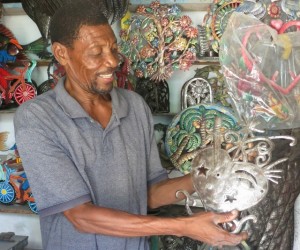March 22, 2013
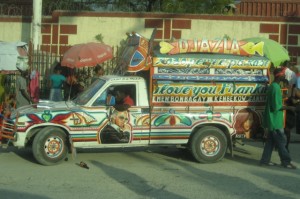 The bright, wildly painted tap-tap buses that fill the roads of Port-au-Prince are a sure bet to be in any photographic record of a trip to Haiti. They are the basic mode of transportation for the populace, a form of organized chaos that moves people from Point A to Point B.
The bright, wildly painted tap-tap buses that fill the roads of Port-au-Prince are a sure bet to be in any photographic record of a trip to Haiti. They are the basic mode of transportation for the populace, a form of organized chaos that moves people from Point A to Point B.
As Amy Wilenz describes it in her book, Farewell Fred Voodoo, “Being in a tap-tap is like being in an open human sardine can. As many people as possible are stuffed inside to make the ride more economically profitable; like the Tokyo subway or a bus in New York at rush hour, but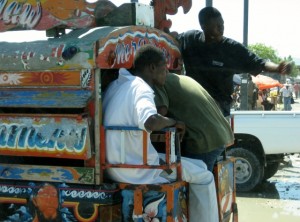 twice as crowded. The seats, should you get one, are not exactly cushioned. And then, of course, it’s very hot in Haiti. And then, of course, the shock absorbers are not so good. And then, of course, the exhaust from the engine comes right back into the passenger area, making everyone slightly nauseated. Also, there is your neighbor on one side who is someone whose generous lap extends pretty much onto yours, and there’s her teenaged daughter who’s sitting on her lap and yours, and there’s an old-fashioned gentleman on the other side trying without success not to make any body contact. And then, of course, there are the animals tied to the vehicle’s sides, usually goats and chickens. Sometimes on top, there are several charcoal ladies with their giant silvery-gray bags of charcoal pushing down on the roof. And then of course, there are the little street boys who attach themselves to the grillwork at the back and cut off any breeze there might be, should the tap-tap actually move.” At best, she
twice as crowded. The seats, should you get one, are not exactly cushioned. And then, of course, it’s very hot in Haiti. And then, of course, the shock absorbers are not so good. And then, of course, the exhaust from the engine comes right back into the passenger area, making everyone slightly nauseated. Also, there is your neighbor on one side who is someone whose generous lap extends pretty much onto yours, and there’s her teenaged daughter who’s sitting on her lap and yours, and there’s an old-fashioned gentleman on the other side trying without success not to make any body contact. And then, of course, there are the animals tied to the vehicle’s sides, usually goats and chickens. Sometimes on top, there are several charcoal ladies with their giant silvery-gray bags of charcoal pushing down on the roof. And then of course, there are the little street boys who attach themselves to the grillwork at the back and cut off any breeze there might be, should the tap-tap actually move.” At best, she 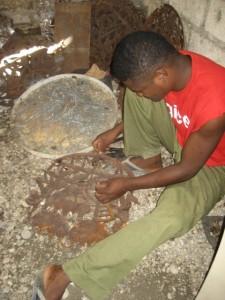 claims, tap-taps motor through the traffic of Port-au-Prince, “at the pace of sludge.
claims, tap-taps motor through the traffic of Port-au-Prince, “at the pace of sludge.
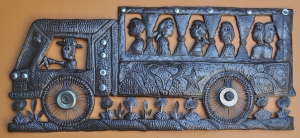
Tap-tap bus (HT1381) One of a Kind sculpture by Jean Eugene Remy
Jean Eugene Remy re-creates the quirky utility of tap-tap in steel. Using bits of wire, he embellishes the wheels and gives character and dimension to his finished product. In his version, the ride becomes a pleasure.
![BlackMadonna[1]](https://blog.itscactus.com/wp-content/uploads/2013/04/BlackMadonna1-201x300.jpg)

